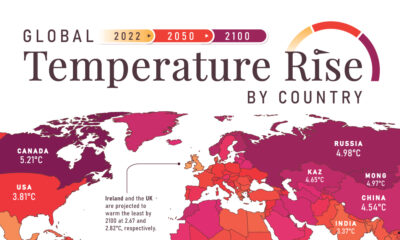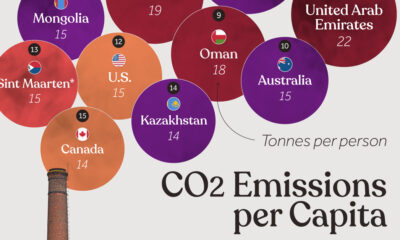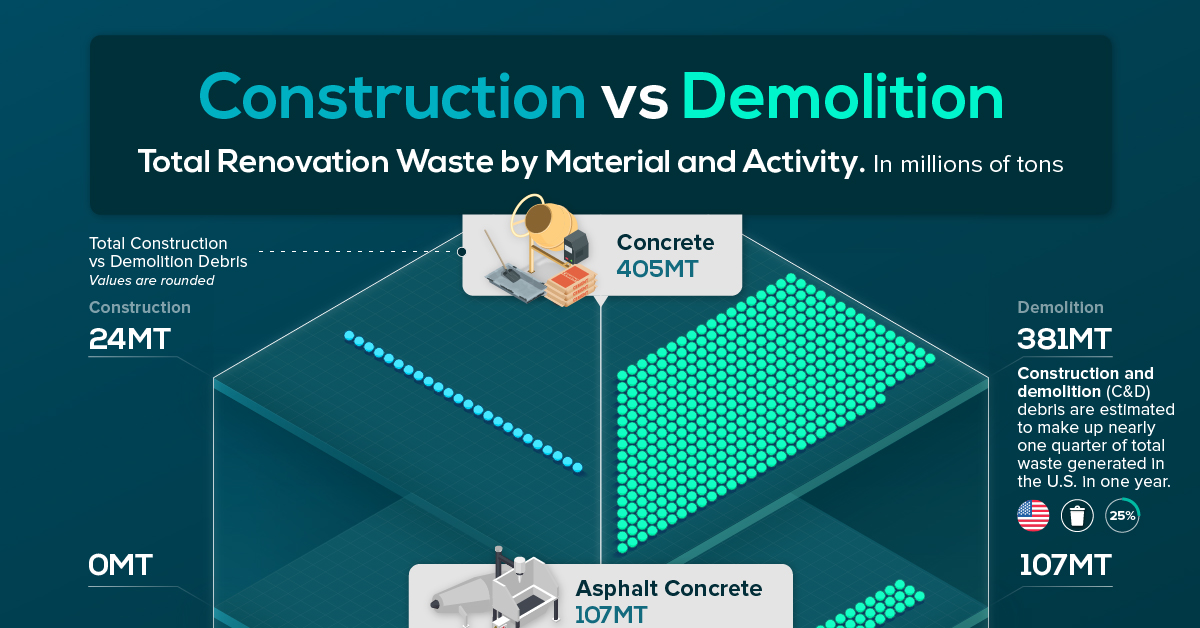How Much Waste Does a Renovation Create?

How Much Waste Does a Renovation Create?
In 2020, the U.S. home remodeling market surpassed a massive $340 billion and is predicted to continue rising at a compound annual growth rate of over 4.1% between 2021 and 2027, according to Global Market Insights.
The problem is home renovations produce a significant amount of waste. In fact, renovations can generate approximately 60 pounds of waste per square foot on average.
With this expected growth in the remodeling market, contractors will need to find new ways to repurpose renovation waste that would otherwise end up in landfill.
In this graphic by Northstar Clean Technologies, we show how much waste can be generated as a result of construction and demolition debris during renovations and how it can be reduced.
Construction and Demolition Waste
Construction and demolition (C&D) debris is estimated to make up nearly one-quarter of the total waste generated in the U.S. in a single year.
Let’s take a look at the breakdown of total construction and demolition debris recorded by the U.S. Environmental Protection Agency in 2018.
| Waste During Construction (million tons) | Demolition Debris (million tons) | Total C&D Debris (million tons) |
|
|---|---|---|---|
| Concrete | 24.2 | 381.0 | 405.2 |
| Wood Products | 3.4 | 37.4 | 40.8 |
| Drywall and Plasters | 3.9 | 11.3 | 15.2 |
| Steel | 0 | 4.7 | 4.7 |
| Brick and Clay Tile | 0.3 | 12.0 | 12.3 |
| Asphalt Shingles | 1.2 | 13.9 | 15.1 |
| Asphalt Concrete | 0 | 107.0 | 107.0 |
| Total | 33.0 | 567.3 | 600.3 |
In 2018, an estimated 600 million tons of C&D debris was generated in the U.S alone. With the remodeling market growing, this number will only continue to rise—and materials contributing to renovation waste can range from concrete to wood and plasters.
Asphalt shingles are among the seven largest contributors to C&D debris, a material that can be found on approximately 75% of homes in the U.S. and Canada.
During a common renovation process, such as re-roofing, the average U.S. home can generate around 3-4 tonnes of tear-off waste.
Technologies Repurposing Waste
More than 90% of used asphalt shingles, equivalent to around 12 million tons, are dumped into landfills in the U.S every year. With oil as its primary component, asphalt shingles are especially harmful to the environment when discarded.
The environmental impact of discarded renovation materials can be avoided through technologies that repurpose these materials such as asphalt shingles.
Northstar Clean Technologies recovers and reprocesses the three primary components of asphalt shingles. The outputs are then sold back into the market as repurposed materials such as liquid asphalt, aggregates, and fiber for use in road construction, embankments, and new shingles.
Northstar Clean Technologies can reduce the impact of renovation waste on the environment. Find more about repurposing asphalt shingles by clicking here now.

-

 Green2 weeks ago
Green2 weeks agoRanked: Top Countries by Total Forest Loss Since 2001
The country with the most forest loss since 2001 lost as much forest cover as the next four countries combined.
-

 Environment2 months ago
Environment2 months agoCharted: Share of World Forests by Country
We visualize which countries have the biggest share of world forests by area—and while country size plays a factor, so too, does the environment.
-

 Environment3 months ago
Environment3 months agoWhich Countries Have the Largest Forests?
Together, the top five countries with the largest forests account for more than half of the world’s entire forest cover.
-

 Healthcare4 months ago
Healthcare4 months agoVisualized: What Lives in Your Gut Microbiome?
The human gut microbiome contains a world of microbes. We look at the the bacteria that deeply affect our health and well-being.
-

 Green4 months ago
Green4 months agoMapped: Global Temperature Rise by Country (2022-2100P)
In this set of three maps, we show the global temperature rise on a national level for 2022, 2050, and 2100 based on an analysis by…
-

 Environment5 months ago
Environment5 months agoRanked: Per Capita Carbon Emissions by Country
Which countries rank the highest in per capita carbon emissions, and how do they impact the world’s total carbon emissions?


